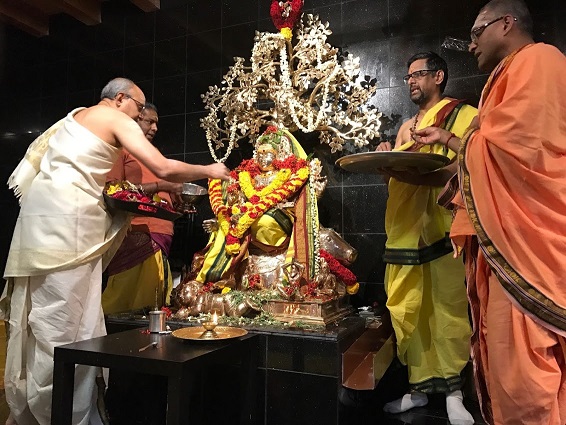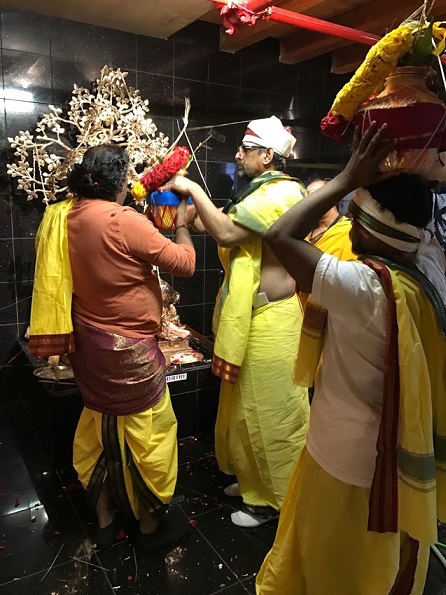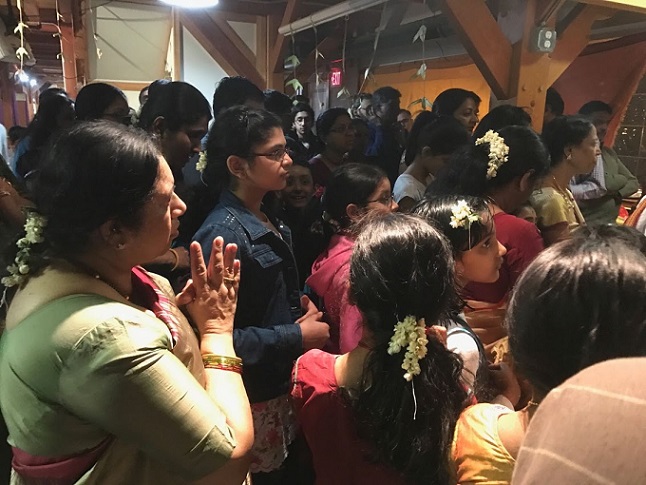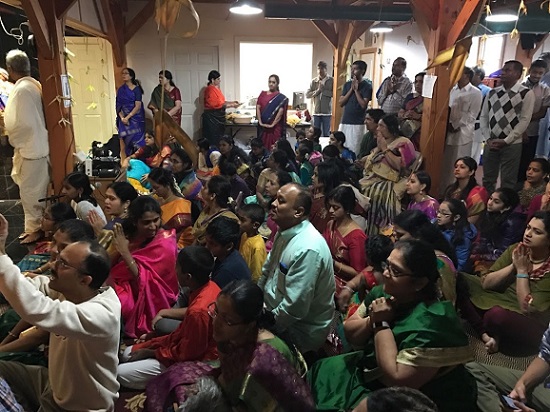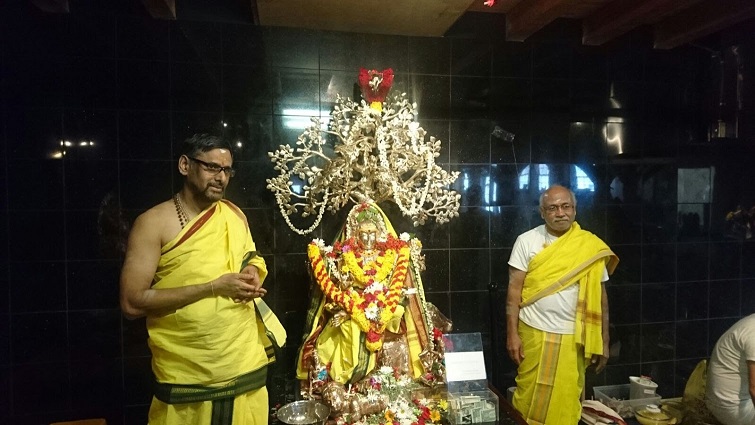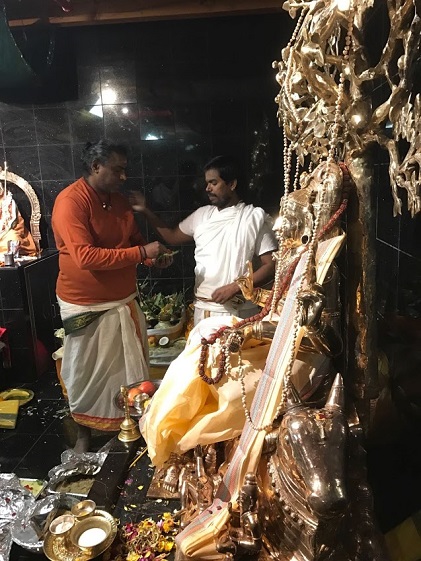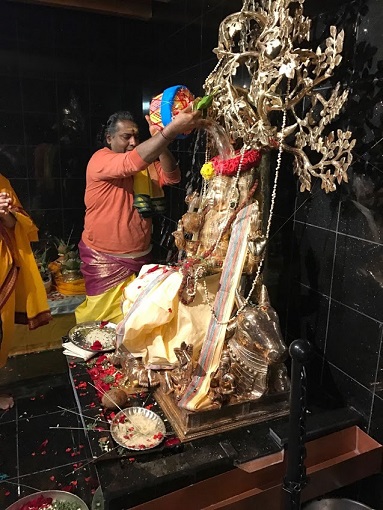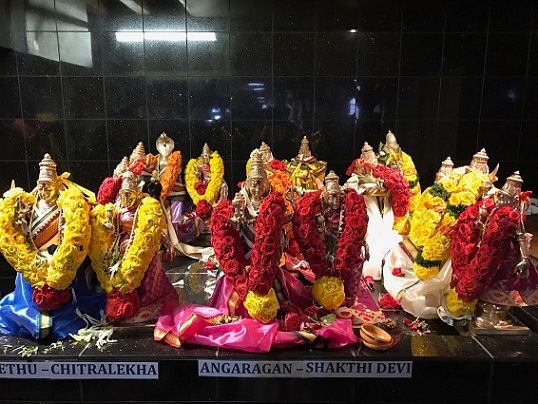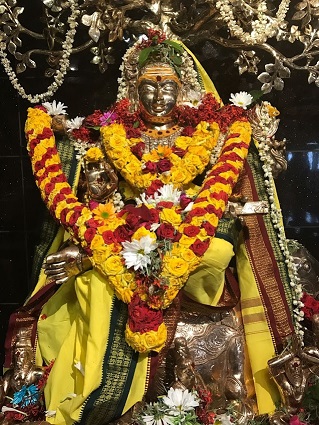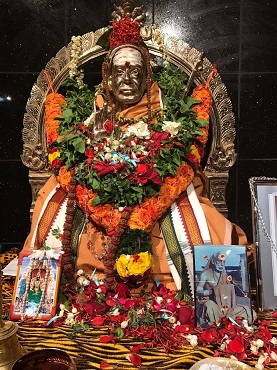Contribute
| New Deities Consecrated At The Hindu Temple Of New Hampshire |
K. Arvind
02/15/2017
ॐ नमो भगवते
दक्षिणामूर्तये The Hindu Temple of New Hampshire, Nashua, NH held a grand consecration function on Sunday,February 5th, 2017, for the newly installed deities of Sri Kanchi Paramacharya, Sri Medha Dakshninamoorti and the Navagraha Devatas. This well-attended function which attracted devotees of all ages from various parts of New Hampshire and Massachusetts, was a lively religious event. The spiritually charged event, which marked the conclusion of a major phase of expansion for the Temple, followed age-old Hindu traditions to instill divine energy and spiritually vitalize the deities. The Temple invites devotees to visit the Temple to have darshan and receive the blessings of the deities. CONSECRATION Consecration of a Temple (“Kumbhabhishekam”) or its deities constitute very significant rituals in a Hindu Temple, as this article from the Harvard University Pluralism Project observes. The consecration function held at the Hindu Temple of New Hampshire on Sunday, February 5th marked the successful completion of a major phase of expansion of the Temple, whose goal was to add shrines for Sri Kanchi Paramacharya who is the source of spiritual inspiration for the establishment and operation of the Temple, Sri Medha Dakshinamoorti, who is Lord Shiva in the form of the ultimate teacher who embodies the highest wisdom, and the Navagraha Devatas, who form an important part of worship in Hindu traditions. The grand consecration function was conducted by Shivacharyar Sri Bhairavasundaram of the Boston Sri Kalikambal Shiva Temple at Bellingham, MA, and Sri Balakrishna Sastry of the Hindu Temple of New Hampshire, who were accompanied by a number of enthusiastic Ritwik volunteers. The consecration functions involved various traditionally prescribed rites including “homa” or “havan” (worship with oblations at fire altars), “abhisheka” (ritual bathing of the vigrahas with sanctified water – a “vigraha” or “murti” represents the sculptural embodiment of a deity), “rakshabandhana” (adornment with a protective thread), “jalaadhivaasam” (purification by immersion in water), “annadhivaasam” (immersion in rice), “netraunmilinam” (opening of the eyes of the murti) and “pranapratishtaa” (establishing the breath in the murti), and accompanied by the chanting of powerful mantras from the sacred vedas. Preparation for the consecration event started more than a week ahead of the grand finale, and included daily chanting of the moola mantras for various deities by devotees every day, and this continued into the final day. Children of Bharati Vidyashram, the cultural wing of the Temple also actively participated in the chanting. The preliminary rituals for the consecration commenced on Friday, February 3rd with Vighneswara Pooja, addressed to Lord Ganesha, the remover of obstacles, and was followed by a homa for Lord Ganesha and the Navagraha Devatas. The rituals on Saturday, February 2nd included Gayathri homa, and abhisheka accompanied by the chanting of Sri Rudram 11 times (“Ekadasha Rudram”) by 11 ritwiks. The rituals on Saturday evening included “pratishtaanga pooja and homa”, and “aavahanti homa”, in addition to “netra unmilinam”. “Netra unmilinam” (opening of the eyes) is one of the critical rites that transform a vigraha from a mere piece of sculpture to an embodiment of the divine. In this interesting ritual, the pupils of the eyes of the vigraha are carved open by an artisan, so devotees can receive the divine gaze of the deity during darshan from that point on. Shivacharyar Sri Bhairavasundaram explained that the ritual opening of the eyes is performed behind a curtain, and the deity is first exposed to sights that are regarded as auspicious, such as an image of the deity itself (by presenting a mirror), a cow (or a picture of a cow), a “sanyasi” (self-realized ascetic – in this case a picture of Sri Paramacharya himself), a married couple, a young boy (“brahmachari”) and a young girl (“kanya”). “Pranaprastishtaa” (breathing of life) is the other critical rite that transforms a moorti into an embodiment of the divine. The purpose of this key ritual which took place at an auspicious hour early morning on Sunday, February 5th was to “establish the breath” in the deities or spiritually vitalize them. After invoking the presence of the divine in the “homa kunda” (fire altar), the power of the divine was ritually transferred to the vigrahas through sacred threads strung from the homa kunda to the vigrahas. After these rites, the deities were opened to the devotees for regular worship. This was later followed by an enactment of a wedding ceremony (“mangalya dharana”) of the various Navagraha Devatas with prayers for the well-being of everyone in the community, which was accompanied by a discourse on the Navagraha Devatas by Sri Bhairavasundaram. The Temple gratefully acknowledges the excellent work done by its untiring volunteers and energetic Annapooranis (who prepared the sumptuous prasad), the generosity of its financial donors, the enthusiastic support of the devotees who thronged the Temple at the auspicious, but not necessarily convenient, hours earmarked for the function. THE VIGRAHAS The “vigrahas” or “moortis” for the newly installed deities were specially commissioned for the Temple and were sculpted by Sri Radhakrishna Sthapathi, the award-winning sculptor and master craftsman from Tamil Nadu, India, whose work adorns the Vellore Golden Temple and Skandashramam in Tamil Nadu. The magnificent “vigrahas” are made of “panchaloha”, a special alloy of 5 metals, and radiate great serenity, grace and presence. They also impart a certain uniqueness to the Hindu Temple of New Hampshire motivating a special reason to visit the Temple. Sri Kanchi Paramacharya, who is revered as the very incarnation of divinity by devotees, is the guiding spiritual Guru and the source of divine inspiration for the establishment and operation of the Hindu Temple of New Hampshire. The “moorti” of Sri Kanchi Paramacharya in the protective abhaya hasta mudra is modeled after the vigraha of Sri Paramacharya at the Sri Mahaperiyava Adhishtanam in Kanchipuram, Tamil Nadu. A darshan of Sri Kanchi Paramacharya at his shrine at the Hindu Temple of New Hampshire, probably the first Temple in North America to house a sanctum for Sri Paramacharya, will certainly be a spiritually fulfilling experience for a devotee. Sri Medha Dakshinamoorti is Lord Shiva in the form of the ultimate teacher who embodies pure knowledge, and who silently imparts the intelligence or wisdom (“medha”) which dispels ignorance and delusion. The south-facing vigraha of Lord Medha Dakshninamoorti installed at the Hindu Temple of New Hampshire, is an awe-inspiring sculpture based on the iconography described in the well-known hymn “Sri Dakshninamoorti Stotram” composed by Sri Adi Shankaracharya over a millennium ago. It is said that by worshipping Lord Sri Dakshninamoorti as Guru, even one without a spiritual guide will eventually be blessed with a self-realized Guru in human form. The Navagraha shrine represents an important and unique addition to the Hindu Temple of New Hampshire. Unlike most Hindu Temples where the Navagraha devatas appear by themselves, each of the Navagraha devatas in the Hindu Temple of New Hampshire, appear with their consorts as well as “vaahanas” (vehicles). DARSHAN With the completion of the consecration function, the new deities are now ritually established in the Hindu Temple of New Hampshire. The Temple invites devotees to visit the Temple, have darshan and receive blessings the deities, and participate, sponsor, and volunteer in various Temple activities. The Temple which is located off Exit 6 on Route 3 is easily accessible from most locations in the Greater Boston area. The Temple has a full-time priest, Sri Balakrishna Sastry. In addition to “nitya aradhana” (daily poojas), the Temple conducts Gayathri Homam on Saturdays and Sundays as part of a year-long Gayathri Maha Yagna, and celebrates many major Hindu festivals. Some of the recent events include “Srinivasa Kalyanam”, Sani Pradosham, “Annabhishekam” for Lord Shiva, “Akhanda Vishnu Sahasranama Parayana”, “Hanumath Jayanthi”, Ekadasha Rudram, Sadashiva Pooja, and Divya Prabhandam Chanting to mark the New Year, the annual Ayyappan Pooja, a memorable highlight of which was a grand Chenda Vadyam and Melam performance by a team led by Sri Gopal. The Temple seeks your patronage and support to help it grow and serve you well. Your donations are tax-deductible and may be made out to HTNH, PO Box 7041, Nashua, NH 03060. Please visit http://www.hindutemplenh.org for general information about the Temple and upcoming events. Please contact Sri Veeramani (hindutempleofnh@gmail.com), for any specific information. Pictures and videos from the event: Link to album with pictures taken by various volunteers
मह्यं प्रज्ञां मेधां प्रयच्छ स्वाहा
“May Lord Sri Dakshinamurti endow us with the
highest wisdom”
(Dakshinamoorti moola mantra –
a Sanskrit prayer addressed to Lord Sri Dakshinamoorti)
You may also access this article through our web-site http://www.lokvani.com/
